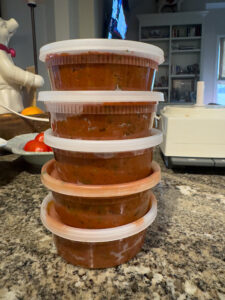Roasted Tomato Sauce/Paste
The Surprising Reality of Roasting Tomatoes: A Journey from Garden to Table
I enjoy experimenting in the kitchen and garden.
Sometimes, taking on a new project is fun, especially when it involves fresh produce from your garden or a generous neighbor’s harvest. But occasionally, the process can surprise you—and not always in the way you’d expect.
This summer, the employee garden at Millstone overflowed with cherry and Roma tomatoes. Seriously, there were so many that the workers offered me some. Naturally, I thought, “Great! I’ll try roasting them to make a delicious sauce.” I’d seen a few recipes and articles about roasting tomatoes, and it seemed like a fun (and tasty) challenge.
The first week, I eagerly started roasting, and guess what? I ended up with a partial quart of roasted tomatoes. Not too bad, right? The second week, I had about half a quart. Okay, next week may be different.
Well, the third week came, and I found myself slicing tomatoes for what felt like hours. Six cookie sheets later, I had a mountain of halved tomatoes ready for the oven.
After everything was said and done, I was left with exactly four quarts of roasted tomatoes.
This week, I decided to turn them into my “sauce.” I sautéed onions, peppers, and garlic, then tossed in at least a cup of my fresh basil leaves. (I’m a bit of a basil enthusiast—nothing like that fresh, fragrant scent.) I blended everything in my Cuisinart, adding a good amount of olive oil as I went along. The final product? Five half-pints of a rich, flavorful tomato paste.
And let me tell you, it was absolutely heavenly. The roasted tomatoes gave the paste this deep, earthy flavor that paired perfectly with a bit of goat cheese, basil, and a cracker.
Honestly, I was proud of myself. But then, I stepped back and looked at the bigger picture: hundreds of tomatoes, and I only got about a quart of usable product.
I called my friend Elizabeth, an incredible cook (and my go-to person for all things Italian), and asked her, “Really? Is that all I get after all that work?” She laughed and said, “Yep, that’s it.”
And that’s when it hit me. I’ll never complain about the price of roasted tomato paste again! The process is time-consuming, and you need a lot of tomatoes to get a small amount of paste. But that’s what makes it so unique. The next time you see a jar of roasted tomato paste at the store, you’ll know why it costs what it does.
If you’re feeling adventurous and want to try this yourself, go for it! (Just be prepared for the time and effort involved.) You can adjust the recipe to suit your tastes—maybe add some different herbs or spices. Or, if you prefer, you can skip the roasting and make a fresh tomato sauce. The choice is yours!
Whatever you decide, remember that the journey is just as important as the result. Sure, after hours of work, you might end up with only a small amount of paste, but the satisfaction of creating something so rich and flavorful from scratch is worth every minute.
So, what do you think? Are you ready to start roasting some tomatoes, or have you already tried it? Either way, I’d love to hear your thoughts (and your recipes, if you’re willing to share).
Let’s keep experimenting together and enjoy every delicious bite along the way.
Roasted Tomato Sauce/Paste
Print Recipe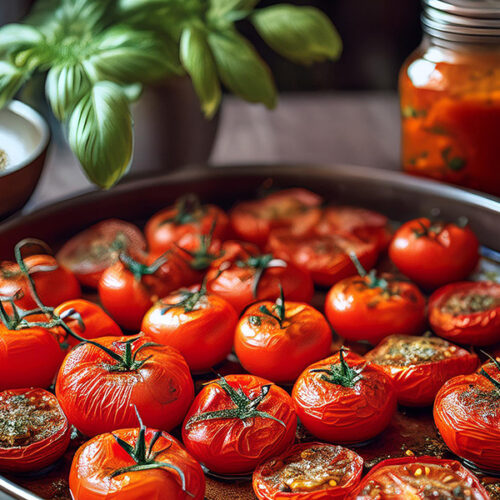
Ingredients
- 6 cookie sheets halved cherry or Roma tomatoes
- 1 large onion, finely chopped
- 2-3 bell peppers, chopped
- 4-6 cloves of garlic, minced
- 1 cup fresh basil leaves, loosely packed
- olive oil
- Salt and pepper to taste
Instructions
Prepare the Tomatoes:
- Preheat your oven to 225°F (110°C).
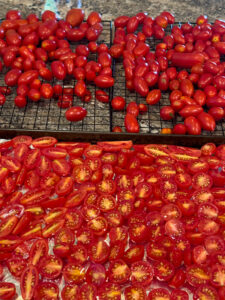
- Slice the tomatoes in half and arrange them on cookie sheets in a single layer, cut side up.
- Drizzle with olive oil and sprinkle with a pinch of salt.
- Roast in the oven for 2-3 hours or until the tomatoes are shriveled and slightly caramelized.
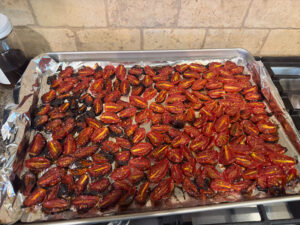
Sauté the Vegetables:
- Heat a few tablespoons of olive oil over medium heat in a large pan.
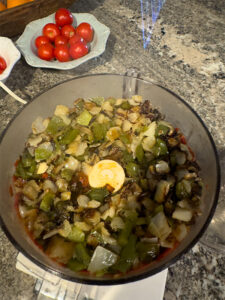
- Add the chopped onions, bell peppers, and minced garlic. Sauté until the onions are translucent and the peppers are soft.
Combine and Blend:
- Once the tomatoes are roasted, add them to the pan with the sautéed vegetables.
- Add the fresh basil leaves and cook for a few more minutes to allow the flavors to meld together.
- Blend the mixture into a smooth paste using a blender or a food processor (like your Cuisinart).
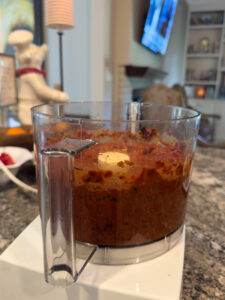
- While blending, slowly add olive oil to achieve a rich, smooth consistency.
Season to Taste:
- After blending, taste your tomato paste and adjust the seasoning with salt and pepper.
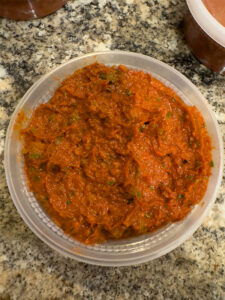
Store:
- Transfer the finished tomato paste into half-pint jars.
- You can store them in the fridge for a week or so or freeze them for extended storage.
